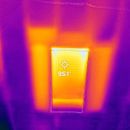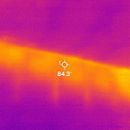Additional Insulation in Cathedral Ceilings
Hello,
I live in South Louisiana and am preparing for our upcoming hot summer. I have a new baby at home so am focusing on making the house much more comfortable for my wife and new little one. My wife was at work last summer so we all avoided being in the house during the hottest parts of the day (for the most part). We do know, however, that the westward parts of our house get hot. We have a great room with cathedral ceilings, half of which are against the roof with sky-lights.
I’ve been looking to plug known leaks and I will install black-out curtains in our great-room. I also borrowed a friend’s thermal camera which brings me to my question. I’ve included thermal images of the cathedral ceilings which shows, I believe, ‘holidays’ in the original fiberglass batting installed at time of construction. I would like to rectify this situation. These areas are adjacent to a couple of skylights and are not accessible via the attic. My initial thought is to poke a hole into the sheet rock and spray some cellulose into what, I believe, is an empty cavity. Any thoughts on the approach?
I also see various hot spots on what I imagine to be the top plate of the wall joists (see, for example the 2nd attachment). Interested in thoughts on these as well.
Finally, I see some places where the top of the wall cavities are very hot. I’m wondering if this is evidence that the fiberglass batts have simply fallen down. Am I free to then punch some cellulose in from the inside?
Thanks in advance!
GBA Detail Library
A collection of one thousand construction details organized by climate and house part












Replies
Bayou3303,
A lot depends on whether the roof is vented or not. If it is the cellulose could block the airflow and cause problems.
Thanks, Malcolm. I have gable vents in my attic and vented eaves at the 'foot' of the roof shown in the picture.
There are currently fiberglass batts installed in the cavities between the roof and the ceiling. I'm not sure if they are vented to allow air to travel from the eave to the peak of the roof.